stop start JEEP WRANGLER UNLIMITED 2021 Owner handbook (in English)
[x] Cancel search | Manufacturer: JEEP, Model Year: 2021, Model line: WRANGLER UNLIMITED, Model: JEEP WRANGLER UNLIMITED 2021Pages: 330, PDF Size: 9.16 MB
Page 67 of 330
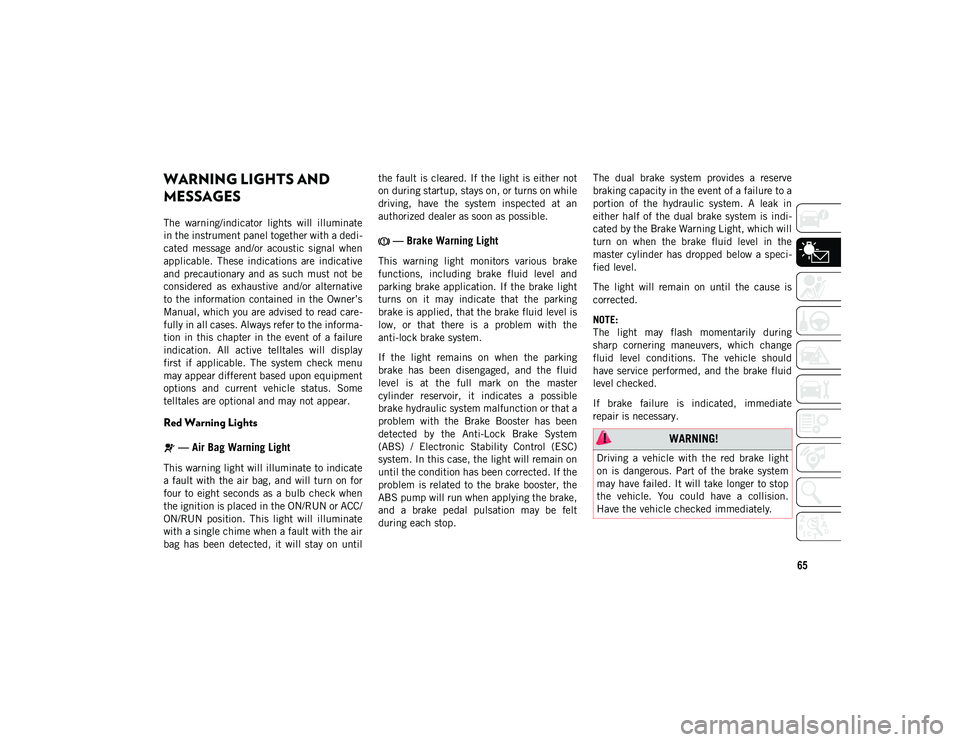
65
WARNING LIGHTS AND
MESSAGES
The warning/indicator lights will illuminate
in the instrument panel together with a dedi-
cated message and/or acoustic signal when
applicable. These indications are indicative
and precautionary and as such must not be
considered as exhaustive and/or alternative
to the information contained in the OwnerŌĆÖs
Manual, which you are advised to read care -
fully in all cases. Always refer to the informa -
tion in this chapter in the event of a failure
indication. All active telltales will display
first if applicable. The system check menu
may appear different based upon equipment
options and current vehicle status. Some
telltales are optional and may not appear.
Red Warning Lights
ŌĆö Air Bag Warning Light
This warning light will illuminate to indicate
a fault with the air bag, and will turn on for
four to eight seconds as a bulb check when
the ignition is placed in the ON/RUN or ACC/
ON/RUN position. This light will illuminate
with a single chime when a fault with the air
bag has been detected, it will stay on until the fault is cleared. If the light is either not
on during startup, stays on, or turns on while
driving, have the system inspected at an
authorized dealer as soon as possible.
ŌĆö Brake Warning Light
This warning light monitors various brake
functions, including brake fluid level and
parking brake application. If the brake light
turns on it may indicate that the parking
brake is applied, that the brake fluid level is
low, or that there is a problem with the
anti-lock brake system.
If the light remains on when the parking
brake has been disengaged, and the fluid
level is at the full mark on the master
cylinder reservoir, it indicates a possible
brake hydraulic system malfunction or that a
problem with the Brake Booster has been
detected by the Anti-Lock Brake System
(ABS) / Electronic Stability Control (ESC)
system. In this case, the light will remain on
until the condition has been corrected. If the
problem is related to the brake booster, the
ABS pump will run when applying the brake,
and a brake pedal pulsation may be felt
during each stop.
The dual brake system provides a reserve
braking capacity in the event of a failure to a
portion of the hydraulic system. A leak in
either half of the dual brake system is indi
-
cated by the Brake Warning Light, which will
turn on when the brake fluid level in the
master cylinder has dropped below a speci -
fied level.
The light will remain on until the cause is
corrected.
NOTE:
The light may flash momentarily during
sharp cornering maneuvers, which change
fluid level conditions. The vehicle should
have service performed, and the brake fluid
level checked.
If brake failure is indicated, immediate
repair is necessary.
WARNING!
Driving a vehicle with the red brake light
on is dangerous. Part of the brake system
may have failed. It will take longer to stop
the vehicle. You could have a collision.
Have the vehicle checked immediately.
2020_JEEP_JL_WRANGLER_UG_RHD_UK.book Page 65
Page 68 of 330
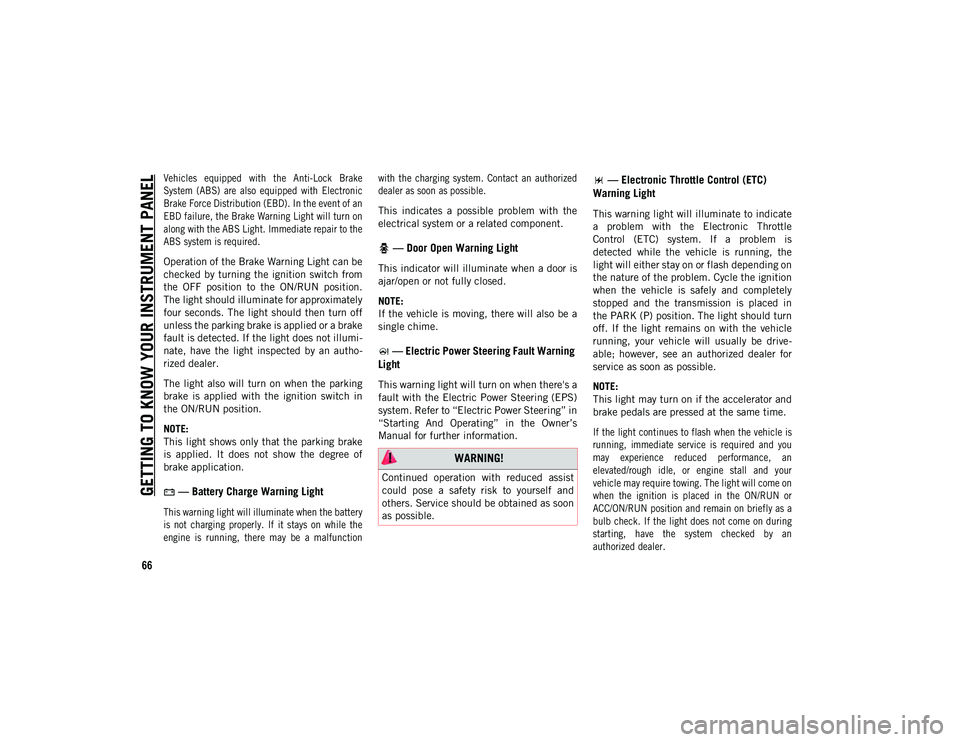
GETTING TO KNOW YOUR INSTRUMENT PANEL
66
Vehicles equipped with the Anti-Lock Brake
System (ABS) are also equipped with Electronic
Brake Force Distribution (EBD). In the event of an
EBD failure, the Brake Warning Light will turn on
along with the ABS Light. Immediate repair to the
ABS system is required.
Operation of the Brake Warning Light can be
checked by turning the ignition switch from
the OFF position to the ON/RUN position.
The light should illuminate for approximately
four seconds. The light should then turn off
unless the parking brake is applied or a brake
fault is detected. If the light does not illumi-
nate, have the light inspected by an autho -
rized dealer.
The light also will turn on when the parking
brake is applied with the ignition switch in
the ON/RUN position.
NOTE:
This light shows only that the parking brake
is applied. It does not show the degree of
brake application.
ŌĆö Battery Charge Warning Light
This warning light will illuminate when the battery
is not charging properly. If it stays on while the
engine is running, there may be a malfunction with the charging system. Contact an authorized
dealer as soon as possible.
This indicates a possible problem with the
electrical system or a related component.
ŌĆö Door Open Warning Light
This indicator will illuminate when a door is
ajar/open or not fully closed.
NOTE:
If the vehicle is moving, there will also be a
single chime.
ŌĆö Electric Power Steering Fault Warning
Light
This warning light will turn on when there's a
fault with the Electric Power Steering (EPS)
system. Refer to ŌĆ£Electric Power SteeringŌĆØ in
ŌĆ£Starting And OperatingŌĆØ in the OwnerŌĆÖs
Manual for further information.
ŌĆö Electronic Throttle Control (ETC)
Warning Light
This warning light will illuminate to indicate
a problem with the Electronic Throttle
Control (ETC) system. If a problem is
detected while the vehicle is running, the
light will either stay on or flash depending on
the nature of the problem. Cycle the ignition
when the vehicle is safely and completely
stopped and the transmission is placed in
the PARK (P) position. The light should turn
off. If the light remains on with the vehicle
running, your vehicle will usually be drive -
able; however, see an authorized dealer for
service as soon as possible.
NOTE:
This light may turn on if the accelerator and
brake pedals are pressed at the same time.
If the light continues to flash when the vehicle is
running, immediate service is required and you
may experience reduced performance, an
elevated/rough idle, or engine stall and your
vehicle may require towing. The light will come on
when the ignition is placed in the ON/RUN or
ACC/ON/RUN position and remain on briefly as a
bulb check. If the light does not come on during
starting, have the system checked by an
authorized dealer.
WARNING!
Continued operation with reduced assist
could pose a safety risk to yourself and
others. Service should be obtained as soon
as possible.
2020_JEEP_JL_WRANGLER_UG_RHD_UK.book Page 66
Page 69 of 330
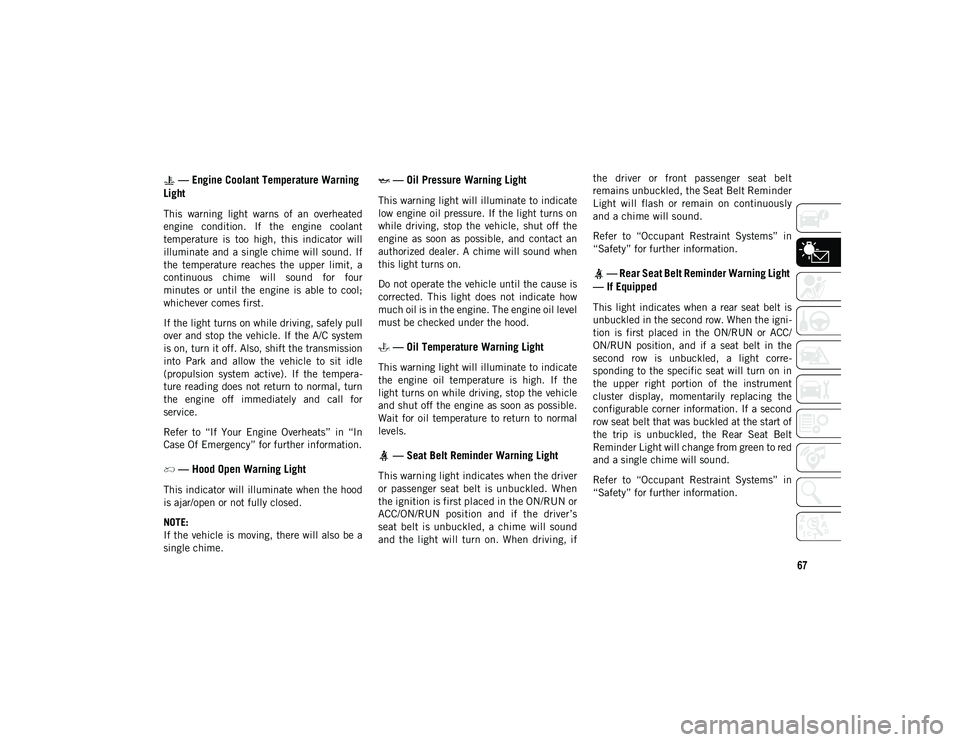
67
ŌĆö Engine Coolant Temperature Warning
Light
This warning light warns of an overheated
engine condition. If the engine coolant
temperature is too high, this indicator will
illuminate and a single chime will sound. If
the temperature reaches the upper limit, a
continuous chime will sound for four
minutes or until the engine is able to cool;
whichever comes first.
If the light turns on while driving, safely pull
over and stop the vehicle. If the A/C system
is on, turn it off. Also, shift the transmission
into Park and allow the vehicle to sit idle
(propulsion system active). If the tempera -
ture reading does not return to normal, turn
the engine off immediately and call for
service.
Refer to ŌĆ£If Your Engine OverheatsŌĆØ in ŌĆ£In
Case Of EmergencyŌĆØ for further information.
ŌĆö Hood Open Warning Light
This indicator will illuminate when the hood
is ajar/open or not fully closed.
NOTE:
If the vehicle is moving, there will also be a
single chime.
ŌĆö Oil Pressure Warning Light
This warning light will illuminate to indicate
low engine oil pressure. If the light turns on
while driving, stop the vehicle, shut off the
engine as soon as possible, and contact an
authorized dealer. A chime will sound when
this light turns on.
Do not operate the vehicle until the cause is
corrected. This light does not indicate how
much oil is in the engine. The engine oil level
must be checked under the hood.
ŌĆö Oil Temperature Warning Light
This warning light will illuminate to indicate
the engine oil temperature is high. If the
light turns on while driving, stop the vehicle
and shut off the engine as soon as possible.
Wait for oil temperature to return to normal
levels.
ŌĆö Seat Belt Reminder Warning Light
This warning light indicates when the driver
or passenger seat belt is unbuckled. When
the ignition is first placed in the ON/RUN or
ACC/ON/RUN position and if the driverŌĆÖs
seat belt is unbuckled, a chime will sound
and the light will turn on. When driving, if the driver or front passenger seat belt
remains unbuckled, the Seat Belt Reminder
Light will flash or remain on continuously
and a chime will sound.
Refer to ŌĆ£Occupant Restraint SystemsŌĆØ in
ŌĆ£SafetyŌĆØ for further information.
ŌĆö Rear Seat Belt Reminder Warning Light
ŌĆö If Equipped
This light indicates when a rear seat belt is
unbuckled in the second row. When the igni -
tion is first placed in the ON/RUN or ACC/
ON/RUN position, and if a seat belt in the
second row is unbuckled, a light corre -
sponding to the specific seat will turn on in
the upper right portion of the instrument
cluster display, momentarily replacing the
configurable corner information. If a second
row seat belt that was buckled at the start of
the trip is unbuckled, the Rear Seat Belt
Reminder Light will change from green to red
and a single chime will sound.
Refer to ŌĆ£Occupant Restraint SystemsŌĆØ in
ŌĆ£SafetyŌĆØ for further information.
2020_JEEP_JL_WRANGLER_UG_RHD_UK.book Page 67
Page 71 of 330
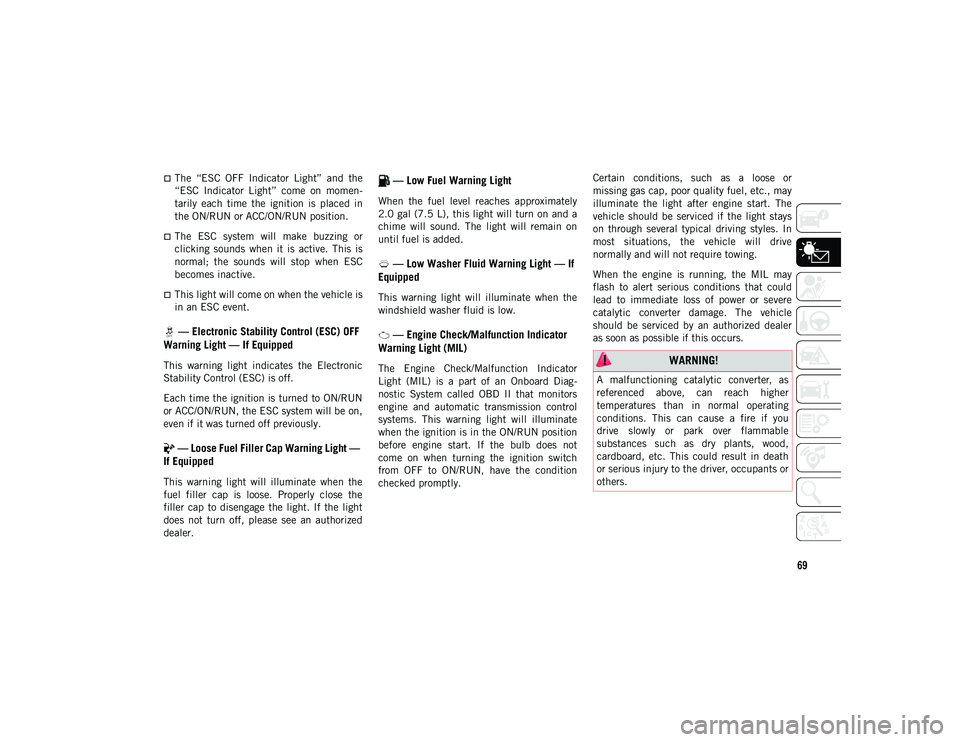
69
’ü»The ŌĆ£ESC OFF Indicator LightŌĆØ and the
ŌĆ£ESC Indicator LightŌĆØ come on momen-
tarily each time the ignition is placed in
the ON/RUN or ACC/ON/RUN position.
’ü»The ESC system will make buzzing or
clicking sounds when it is active. This is
normal; the sounds will stop when ESC
becomes inactive.
’ü»This light will come on when the vehicle is
in an ESC event.
ŌĆö Electronic Stability Control (ESC) OFF
Warning Light ŌĆö If Equipped
This warning light indicates the Electronic
Stability Control (ESC) is off.
Each time the ignition is turned to ON/RUN
or ACC/ON/RUN, the ESC system will be on,
even if it was turned off previously.
ŌĆö Loose Fuel Filler Cap Warning Light ŌĆö
If Equipped
This warning light will illuminate when the
fuel filler cap is loose. Properly close the
filler cap to disengage the light. If the light
does not turn off, please see an authorized
dealer.
ŌĆö Low Fuel Warning Light
When the fuel level reaches approximately
2.0 gal (7.5 L), this light will turn on and a
chime will sound. The light will remain on
until fuel is added.
ŌĆö Low Washer Fluid Warning Light ŌĆö If
Equipped
This warning light will illuminate when the
windshield washer fluid is low.
ŌĆö Engine Check/Malfunction Indicator
Warning Light (MIL)
The Engine Check/Malfunction Indicator
Light (MIL) is a part of an Onboard Diag -
nostic System called OBD II that monitors
engine and automatic transmission control
systems. This warning light will illuminate
when the ignition is in the ON/RUN position
before engine start. If the bulb does not
come on when turning the ignition switch
from OFF to ON/RUN, have the condition
checked promptly. Certain conditions, such as a loose or
missing gas cap, poor quality fuel, etc., may
illuminate the light after engine start. The
vehicle should be serviced if the light stays
on through several typical driving styles. In
most situations, the vehicle will drive
normally and will not require towing.
When the engine is running, the MIL may
flash to alert serious conditions that could
lead to immediate loss of power or severe
catalytic converter damage. The vehicle
should be serviced by an authorized dealer
as soon as possible if this occurs. WARNING!
A malfunctioning catalytic converter, as
referenced above, can reach higher
temperatures than in normal operating
conditions. This can cause a fire if you
drive slowly or park over flammable
substances such as dry plants, wood,
cardboard, etc. This could result in death
or serious injury to the driver, occupants or
others.
2020_JEEP_JL_WRANGLER_UG_RHD_UK.book Page 69
Page 72 of 330

GETTING TO KNOW YOUR INSTRUMENT PANEL
70
ŌĆö AdBlue┬« Injection System Failure
Warning Light ŌĆö If Equipped
This warning light will illuminate along with
a dedicated message on the display (If
Equipped) if an unknown fluid not
conforming with acceptable characteristics
is inserted, or if an average consumption of
AdBlue® over 50% is detected. Contact an
authorized dealer as soon as possible.
If the problem is not solved, a specific
message will appear on the Instrument
Cluster Display whenever a certain threshold
is reached until it will no longer be possible
to start the engine. When about 125 miles (200 km) are
remaining before the AdBlue® tank is
empty, a continuous dedicated message will
appear on the instrument panel, accompa
-
nied by a buzzer sound (If Equipped).
ŌĆö Service 4WD Warning Light ŌĆö If
Equipped
This warning light will illuminate to signal a
fault with the 4WD system. If the light stays on
or comes on during driving, it means that the
4WD system is not functioning properly and
that service is required. It is recommended you
drive to the nearest service center and have the
vehicle serviced immediately.
ŌĆö Service Forward Collision Warning
(FCW) Light ŌĆö If Equipped
This warning light will illuminate to indicate
a fault in the Forward Collision Warning
System. Contact an authorized dealer for
service.
Refer to "Forward Collision Warning (FCW)"
in "Safety" for further information.
ŌĆö Service Stop/Start System Warning
Light ŌĆö If Equipped
This warning light will illuminate when the
Stop/Start system is not functioning properly
and service is required. Contact an autho -
rized dealer for service.
ŌĆö Speed Control Fault Warning Light
This warning light will illuminate to indicate
the Speed Control System is not functioning
properly and service is required. Contact an
authorized dealer.
ŌĆö Sway Bar Fault Warning Light
This light will illuminate when there is a fault
in the sway bar disconnect system.
ŌĆö Tire Pressure Monitoring System
(TPMS) Warning Light
The warning light switches on and a message
is displayed to indicate that the tire pressure
is lower than the recommended value and/or
that slow pressure loss is occurring. In these
cases, optimal tire duration and fuel
consumption may not be guaranteed.
CAUTION!
Prolonged driving with the Malfunction
Indicator Light (MIL) on could cause
damage to the vehicle control system. It
also could affect fuel economy and
driveability. If the MIL is flashing, severe
catalytic converter damage and power loss
will soon occur. Immediate service is
required.
2020_JEEP_JL_WRANGLER_UG_RHD_UK.book Page 70
Page 73 of 330
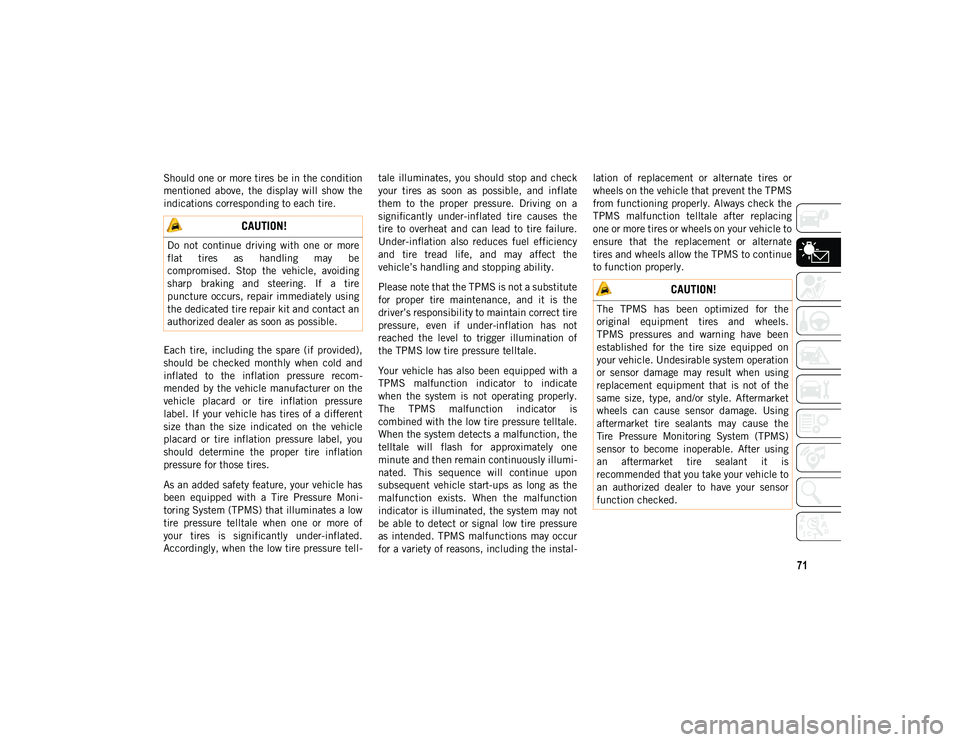
71
Should one or more tires be in the condition
mentioned above, the display will show the
indications corresponding to each tire.
Each tire, including the spare (if provided),
should be checked monthly when cold and
inflated to the inflation pressure recom-
mended by the vehicle manufacturer on the
vehicle placard or tire inflation pressure
label. If your vehicle has tires of a different
size than the size indicated on the vehicle
placard or tire inflation pressure label, you
should determine the proper tire inflation
pressure for those tires.
As an added safety feature, your vehicle has
been equipped with a Tire Pressure Moni -
toring System (TPMS) that illuminates a low
tire pressure telltale when one or more of
your tires is significantly under-inflated.
Accordingly, when the low tire pressure tell -tale illuminates, you should stop and check
your tires as soon as possible, and inflate
them to the proper pressure. Driving on a
significantly under-inflated tire causes the
tire to overheat and can lead to tire failure.
Under-inflation also reduces fuel efficiency
and tire tread life, and may affect the
vehicleŌĆÖs handling and stopping ability.
Please note that the TPMS is not a substitute
for proper tire maintenance, and it is the
driverŌĆÖs responsibility to maintain correct tire
pressure, even if under-inflation has not
reached the level to trigger illumination of
the TPMS low tire pressure telltale.
Your vehicle has also been equipped with a
TPMS malfunction indicator to indicate
when the system is not operating properly.
The TPMS malfunction indicator is
combined with the low tire pressure telltale.
When the system detects a malfunction, the
telltale will flash for approximately one
minute and then remain continuously illumi
-
nated. This sequence will continue upon
subsequent vehicle start-ups as long as the
malfunction exists. When the malfunction
indicator is illuminated, the system may not
be able to detect or signal low tire pressure
as intended. TPMS malfunctions may occur
for a variety of reasons, including the instal -lation of replacement or alternate tires or
wheels on the vehicle that prevent the TPMS
from functioning properly. Always check the
TPMS malfunction telltale after replacing
one or more tires or wheels on your vehicle to
ensure that the replacement or alternate
tires and wheels allow the TPMS to continue
to function properly.
CAUTION!
Do not continue driving with one or more
flat tires as handling may be
compromised. Stop the vehicle, avoiding
sharp braking and steering. If a tire
puncture occurs, repair immediately using
the dedicated tire repair kit and contact an
authorized dealer as soon as possible.
CAUTION!
The TPMS has been optimized for the
original equipment tires and wheels.
TPMS pressures and warning have been
established for the tire size equipped on
your vehicle. Undesirable system operation
or sensor damage may result when using
replacement equipment that is not of the
same size, type, and/or style. Aftermarket
wheels can cause sensor damage. Using
aftermarket tire sealants may cause the
Tire Pressure Monitoring System (TPMS)
sensor to become inoperable. After using
an aftermarket tire sealant it is
recommended that you take your vehicle to
an authorized dealer to have your sensor
function checked.
2020_JEEP_JL_WRANGLER_UG_RHD_UK.book Page 71
Page 76 of 330
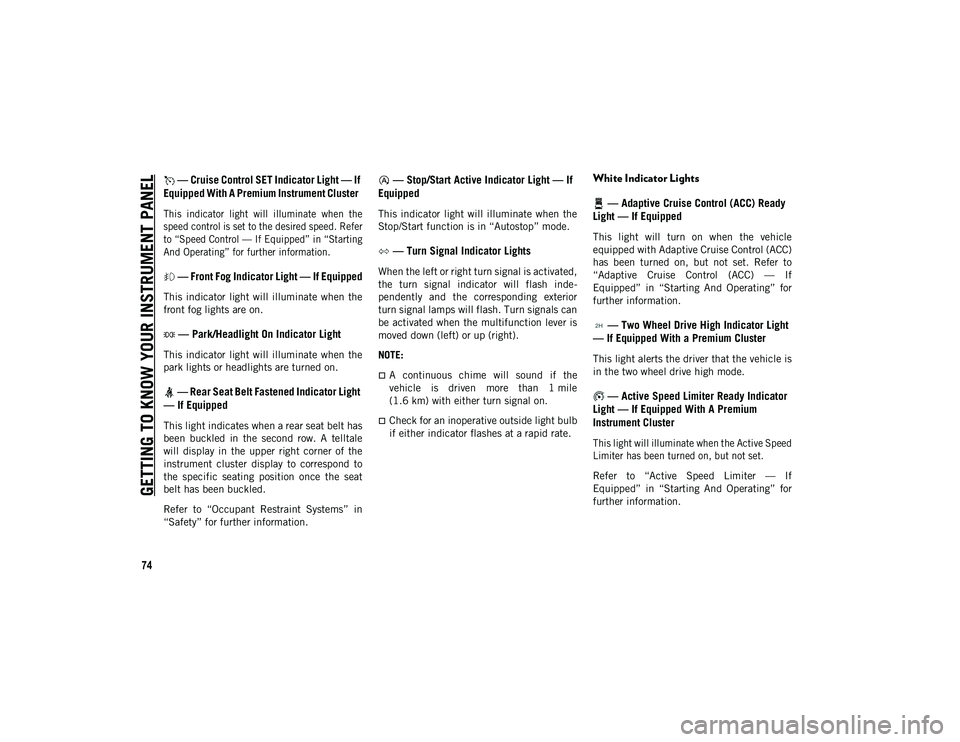
GETTING TO KNOW YOUR INSTRUMENT PANEL
74
ŌĆö Cruise Control SET Indicator Light ŌĆö If
Equipped With A Premium Instrument Cluster
This indicator light will illuminate when the
speed control is set to the desired speed. Refer
to ŌĆ£Speed Control ŌĆö If EquippedŌĆØ in ŌĆ£Starting
And OperatingŌĆØ for further information.
ŌĆö Front Fog Indicator Light ŌĆö If Equipped
This indicator light will illuminate when the
front fog lights are on.
ŌĆö Park/Headlight On Indicator Light
This indicator light will illuminate when the
park lights or headlights are turned on.
ŌĆö Rear Seat Belt Fastened Indicator Light
ŌĆö If Equipped
This light indicates when a rear seat belt has
been buckled in the second row. A telltale
will display in the upper right corner of the
instrument cluster display to correspond to
the specific seating position once the seat
belt has been buckled.
Refer to ŌĆ£Occupant Restraint SystemsŌĆØ in
ŌĆ£SafetyŌĆØ for further information.
ŌĆö Stop/Start Active Indicator Light ŌĆö If
Equipped
This indicator light will illuminate when the
Stop/Start function is in ŌĆ£AutostopŌĆØ mode.
ŌĆö Turn Signal Indicator Lights
When the left or right turn signal is activated,
the turn signal indicator will flash inde -
pendently and the corresponding exterior
turn signal lamps will flash. Turn signals can
be activated when the multifunction lever is
moved down (left) or up (right).
NOTE:
’ü»A continuous chime will sound if the
vehicle is driven more than 1 mile
(1.6 km) with either turn signal on.
’ü»Check for an inoperative outside light bulb
if either indicator flashes at a rapid rate.
White Indicator Lights
ŌĆö Adaptive Cruise Control (ACC) Ready
Light ŌĆö If Equipped
This light will turn on when the vehicle
equipped with Adaptive Cruise Control (ACC)
has been turned on, but not set. Refer to
ŌĆ£Adaptive Cruise Control (ACC) ŌĆö If
EquippedŌĆØ in ŌĆ£Starting And OperatingŌĆØ for
further information.
ŌĆö Two Wheel Drive High Indicator Light
ŌĆö If Equipped With a Premium Cluster
This light alerts the driver that the vehicle is
in the two wheel drive high mode.
ŌĆö Active Speed Limiter Ready Indicator
Light ŌĆö If Equipped With A Premium
Instrument Cluster
This light will illuminate when the Active Speed
Limiter has been turned on, but not set.
Refer to ŌĆ£Active Speed Limiter ŌĆö If
EquippedŌĆØ in ŌĆ£Starting And OperatingŌĆØ for
further information.
2020_JEEP_JL_WRANGLER_UG_RHD_UK.book Page 74
Page 80 of 330
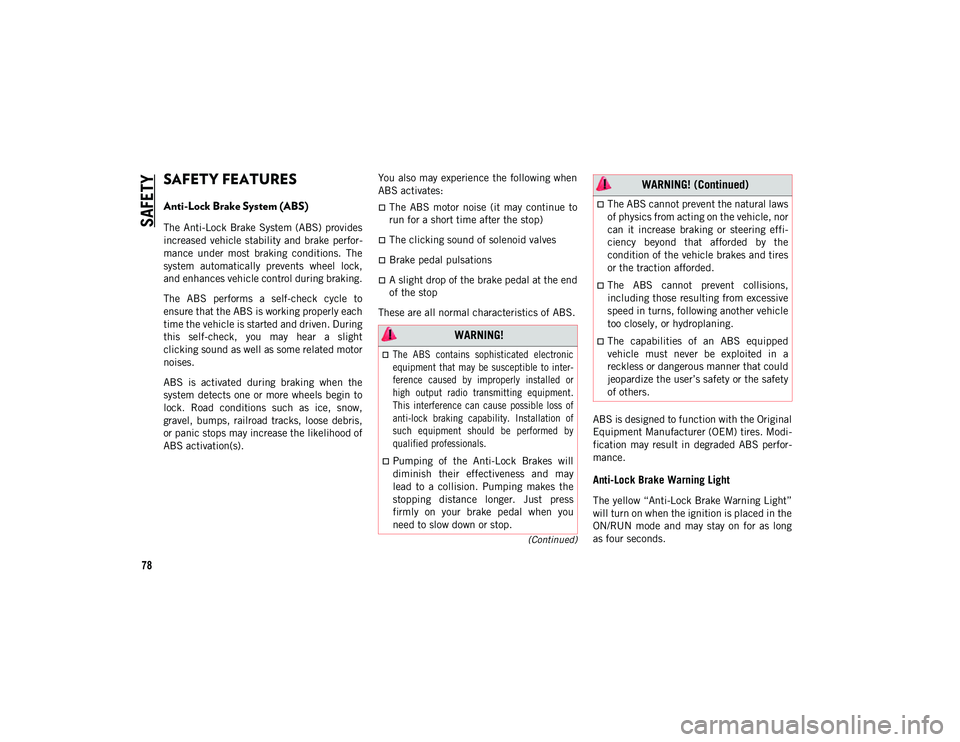
78
(Continued)
SAFETY
SAFETY FEATURES
Anti-Lock Brake System (ABS)
The Anti-Lock Brake System (ABS) provides
increased vehicle stability and brake perfor-
mance under most braking conditions. The
system automatically prevents wheel lock,
and enhances vehicle control during braking.
The ABS performs a self-check cycle to
ensure that the ABS is working properly each
time the vehicle is started and driven. During
this self-check, you may hear a slight
clicking sound as well as some related motor
noises.
ABS is activated during braking when the
system detects one or more wheels begin to
lock. Road conditions such as ice, snow,
gravel, bumps, railroad tracks, loose debris,
or panic stops may increase the likelihood of
ABS activation(s). You also may experience the following when
ABS activates:
’ü»The ABS motor noise (it may continue to
run for a short time after the stop)
’ü»The clicking sound of solenoid valves
’ü»Brake pedal pulsations
’ü»A slight drop of the brake pedal at the end
of the stop
These are all normal characteristics of ABS.
ABS is designed to function with the Original
Equipment Manufacturer (OEM) tires. Modi-
fication may result in degraded ABS perfor -
mance.
Anti-Lock Brake Warning Light
The yellow ŌĆ£Anti-Lock Brake Warning LightŌĆØ
will turn on when the ignition is placed in the
ON/RUN mode and may stay on for as long
as four seconds.
WARNING!
’ü»The ABS contains sophisticated electronic
equipment that may be susceptible to inter -
ference caused by improperly installed or
high output radio transmitting equipment.
This interference can cause possible loss of
anti-lock braking capability. Installation of
such equipment should be performed by
qualified professionals.
’ü»Pumping of the Anti-Lock Brakes will
diminish their effectiveness and may
lead to a collision. Pumping makes the
stopping distance longer. Just press
firmly on your brake pedal when you
need to slow down or stop.
’ü»The ABS cannot prevent the natural laws
of physics from acting on the vehicle, nor
can it increase braking or steering effi -
ciency beyond that afforded by the
condition of the vehicle brakes and tires
or the traction afforded.
’ü»The ABS cannot prevent collisions,
including those resulting from excessive
speed in turns, following another vehicle
too closely, or hydroplaning.
’ü»The capabilities of an ABS equipped
vehicle must never be exploited in a
reckless or dangerous manner that could
jeopardize the userŌĆÖs safety or the safety
of others.
WARNING! (Continued)
2020_JEEP_JL_WRANGLER_UG_RHD_UK.book Page 78
Page 81 of 330
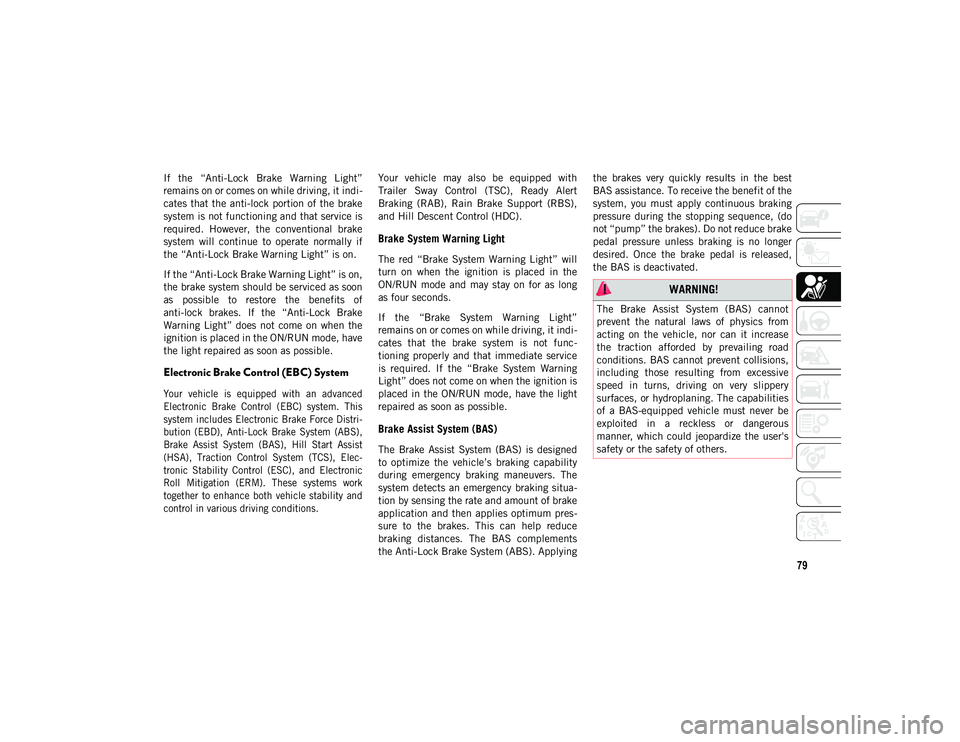
79
If the ŌĆ£Anti-Lock Brake Warning LightŌĆØ
remains on or comes on while driving, it indi-
cates that the anti-lock portion of the brake
system is not functioning and that service is
required. However, the conventional brake
system will continue to operate normally if
the ŌĆ£Anti-Lock Brake Warning LightŌĆØ is on.
If the ŌĆ£Anti-Lock Brake Warning LightŌĆØ is on,
the brake system should be serviced as soon
as possible to restore the benefits of
anti-lock brakes. If the ŌĆ£Anti-Lock Brake
Warning LightŌĆØ does not come on when the
ignition is placed in the ON/RUN mode, have
the light repaired as soon as possible.
Electronic Brake Control (EBC) System
Your vehicle is equipped with an advanced
Electronic Brake Control (EBC) system. This
system includes Electronic Brake Force Distri -
bution (EBD), Anti-Lock Brake System (ABS),
Brake Assist System (BAS), Hill Start Assist
(HSA), Traction Control System (TCS), Elec-
tronic Stability Control (ESC), and Electronic
Roll Mitigation (ERM). These systems work
together to enhance both vehicle stability and
control in various driving conditions.
Your vehicle may also be equipped with
Trailer Sway Control (TSC), Ready Alert
Braking (RAB), Rain Brake Support (RBS),
and Hill Descent Control (HDC).
Brake System Warning Light
The red ŌĆ£Brake System Warning LightŌĆØ will
turn on when the ignition is placed in the
ON/RUN mode and may stay on for as long
as four seconds.
If the ŌĆ£Brake System Warning LightŌĆØ
remains on or comes on while driving, it indi
-
cates that the brake system is not func -
tioning properly and that immediate service
is required. If the ŌĆ£Brake System Warning
LightŌĆØ does not come on when the ignition is
placed in the ON/RUN mode, have the light
repaired as soon as possible.
Brake Assist System (BAS)
The Brake Assist System (BAS) is designed
to optimize the vehicleŌĆÖs braking capability
during emergency braking maneuvers. The
system detects an emergency braking situa -
tion by sensing the rate and amount of brake
application and then applies optimum pres -
sure to the brakes. This can help reduce
braking distances. The BAS complements
the Anti-Lock Brake System (ABS). Applying the brakes very quickly results in the best
BAS assistance. To receive the benefit of the
system, you must apply continuous braking
pressure during the stopping sequence, (do
not ŌĆ£pumpŌĆØ the brakes). Do not reduce brake
pedal pressure unless braking is no longer
desired. Once the brake pedal is released,
the BAS is deactivated.
WARNING!
The Brake Assist System (BAS) cannot
prevent the natural laws of physics from
acting on the vehicle, nor can it increase
the traction afforded by prevailing road
conditions. BAS cannot prevent collisions,
including those resulting from excessive
speed in turns, driving on very slippery
surfaces, or hydroplaning. The capabilities
of a BAS-equipped vehicle must never be
exploited in a reckless or dangerous
manner, which could jeopardize the user's
safety or the safety of others.
2020_JEEP_JL_WRANGLER_UG_RHD_UK.book Page 79
Page 85 of 330

83
The ŌĆ£ESC Activation/Malfunction Indicator
LightŌĆØ (located in the instrument cluster)
starts to flash as soon as the tires lose trac-
tion and the ESC system becomes active.
The ŌĆ£ESC Activation/Malfunction Indicator
LightŌĆØ also flashes when TCS is active. If the
ŌĆ£ESC Activation/Malfunction Indicator
LightŌĆØ begins to flash during acceleration,
ease up on the accelerator and apply as little
throttle as possible. Be sure to adapt your
speed and driving to the prevailing road
conditions.
NOTE:
’ü»The ŌĆ£ESC Activation/Malfunction Indi -
cator LightŌĆØ and the ŌĆ£ESC OFF Indicator
LightŌĆØ come on momentarily each time
the ignition is turned ON.
’ü»Each time the ignition is turned ON, the
ESC system will be on even if it was turned
off previously.
’ü»The ESC system will make buzzing or
clicking sounds when it is active. This is
normal; the sounds will stop when ESC
becomes inactive following the maneuver
that caused the ESC activation. The ŌĆ£ESC OFF Indicator LightŌĆØ
indicates the customer has elected
to have the Electronic Stability
Control (ESC) in a reduced mode.
Hill Descent Control (HDC) ŌĆö If Equipped
Hill Descent Control (HDC) is intended for
low speed off road driving while in 4L Range.
HDC maintains vehicle speed while
descending hills during various driving situa
-
tions. HDC controls vehicle speed by actively
controlling the brakes.
HDC has three states:
1. Off (feature is not enabled and will not activate)
2. Enabled (feature is enabled and ready but activation conditions are not met, or
driver is actively overriding with brake or
throttle application)
3. Active (feature is enabled and actively controlling vehicle speed) Enabling HDC
HDC is enabled by pushing the HDC switch,
but the following conditions must also be
met to enable HDC:
’ü»Driveline is in 4L Range
’ü»Vehicle speed is below 5 mph (8 km/h)
’ü»Park brake is released
’ü»Driver door is closed (If doors are
attached, then door must be closed. If
doors are detached, then driver seatbelt
must be buckled)
Activating HDC
Once HDC is enabled it will activate auto -
matically if driven down a grade of sufficient
magnitude. The set speed for HDC is select -
able by the driver, and can be adjusted by
using the gear shift +/-. The following
summarizes the HDC set speeds:
HDC Target Set Speeds
’ü»P = No set speed. HDC may be enabled
but will not activate
’ü»R = 0.6 mph (1 km/h)
’ü»N = 1.2 mph (2 km/h)
2020_JEEP_JL_WRANGLER_UG_RHD_UK.book Page 83